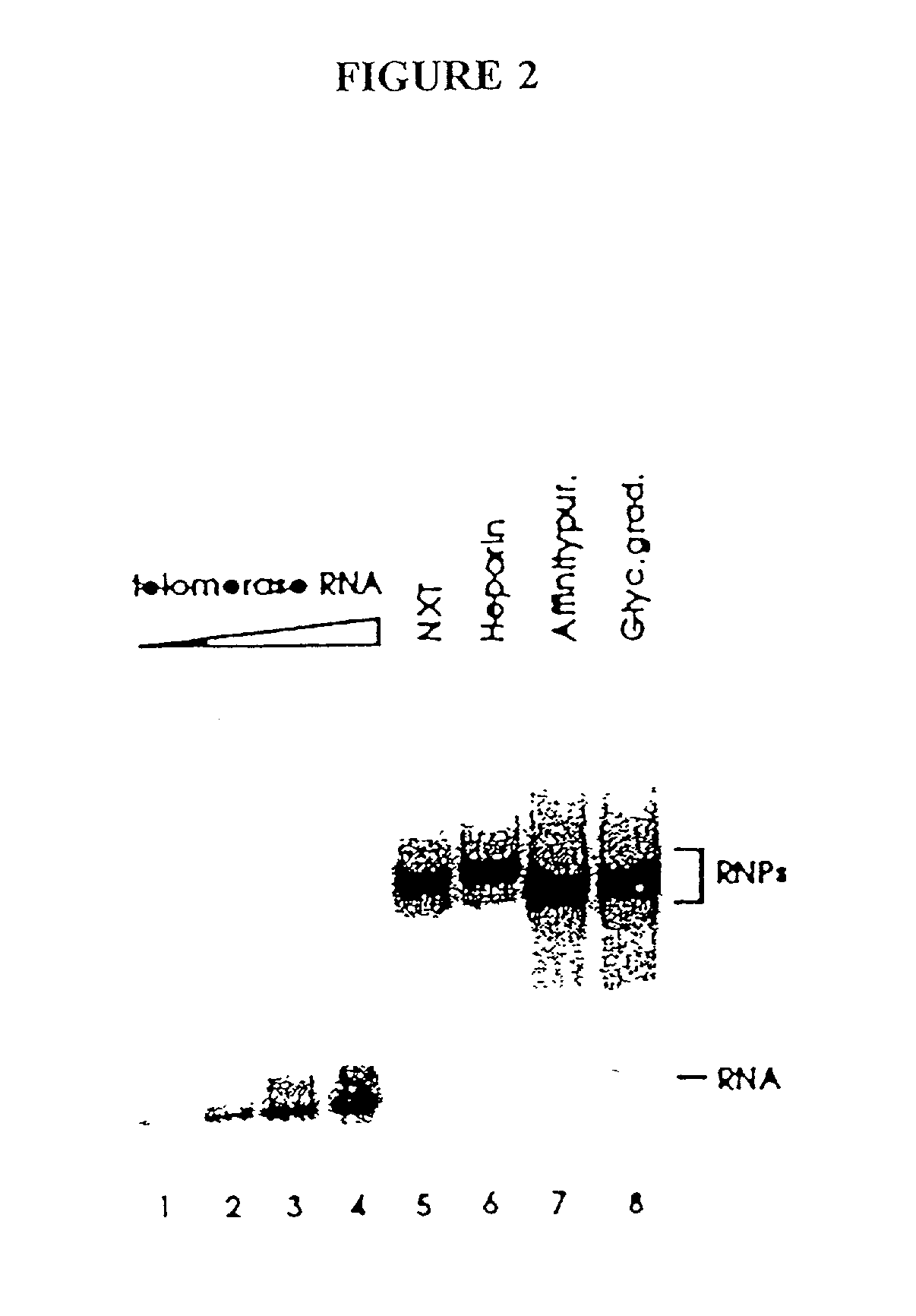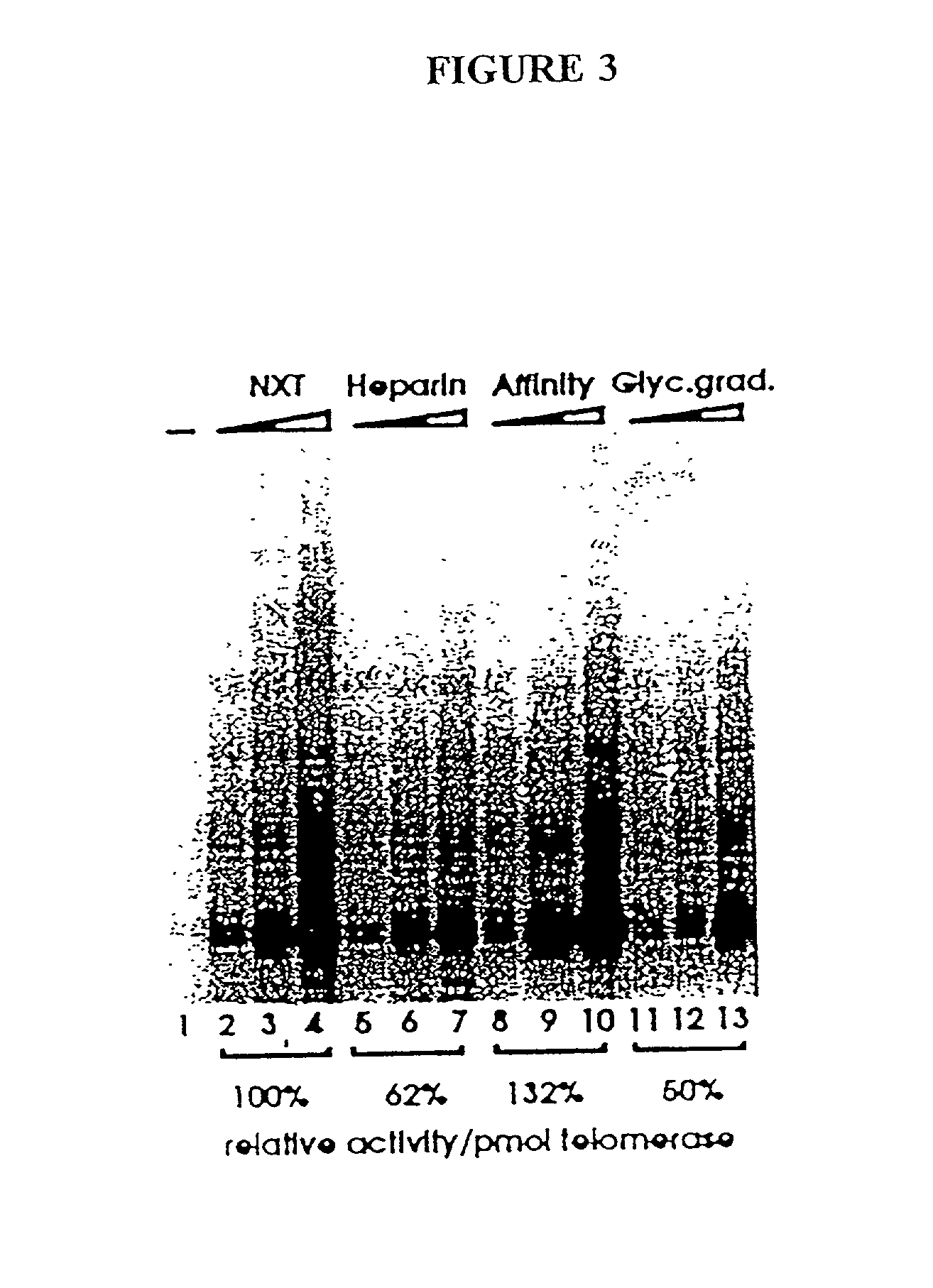Novel telomerase
a technology of telomerase and telomerase, which is applied in the field of new telomerase, can solve the problems of unable to begin dna synthesis de novo, the end of linear eukaryotic chromosome replication presents special problems for conventional methods of dna replication, and the inability of conventional dna polymerases to identify even loose consensus sequences to describe, etc., and achieves stable expression
- Summary
- Abstract
- Description
- Claims
- Application Information
AI Technical Summary
Benefits of technology
Problems solved by technology
Method used
Image
Examples
example 2
Preparation of Nuclear Extracts
[0268] In this Example, nuclear extracts of E. aediculatus were prepared using the method of Lingner et al., (Lingner et al., Genes Develop., 8:1984 [1994]), with minor modifications, as indicated below. Briefly, cells grown as described in Example 1 were concentrated with 15 .mu.m Nytex filters and cooled on ice. The cell pellet was resuspended in a final volume of 110 ml TMS / PMSF / spermidinephosphate buffer. The stock TMS / PMSF / spermidine phosphate buffer was prepared by adding 0.075 g spermidine phosphate (USB) and 0.75 ml PMSF (from 100 mM stock prepared in ethanol) to 150 ml TMS. TMS comprised 10 mM Tris-acetate, 10 mM MgCl.sub.2, 85.5752 g sucrose / liter, and 0.33297 g CaCl.sub.2 / liter, pH 7.5.
[0269] After resuspension in TMS / PMSF / spermidinephosphate buffer, 8.8 ml 10% NP-40 and 94.1 g sucrose were added and the mixture placed in a siliconized glass beaker with a stainless steel stirring rod attached to an overhead motor. The mixture was stirred unt...
example 3
Purification of Telomerase
[0271] In this Example, nuclear extracts prepared as described in Example 2 were used to purify E. aediculatus telomerase. In this purification protocol, telomerase was first enriched by chromatography on an Affi-Gel-heparin column, and then extensively purified by affinity purification with an antisense oligonucleotide. As the template region of telomerase RNA is accessible to hybridization in the telomerase RNP particle, an antisense oligonucletide (i.e., the "affinity oligonucleotide") was synthesized that was complementary to this template region as an affinity bait for the telomerase. A biotin residue was included at the 5' end of the oligonucleotide to immobilize it to an avidin column.
[0272] Following the binding of the telomerase to the oligonucleotide, and extensive washing, the telomerase was eluted by use of a displacement oligonucleotide. The affinity oligonucleotide included DNA bases that were not complementary to the telomerase RNA 5' to the ...
example 4
Telomerase Activity
[0284] At each step in the purification of telomerase, the preparation was analyzed by three separate assays, one of which was activity, as described in this Example. In general, telomerase assays were done in 40 .mu.l containing 0.003-0.3 .mu.l of nuclear extract, 50 mM Tris-Cl (pH 7.5), 50 mM KGlu, 10 mM MgCl.sub.2, 1 mM DTT, 125 .mu.M dTTP, 125 .mu.M dGTP, and approximately 0.2 pmoles of 5'-.sup.32P-labelled oligonucleotide substrate (i.e., approximately 400,000 cpm). Oligonucleotide primers were heat-denatured prior to their addition to the reaction mixture. Reactions were assembled on ice and incubated for 30 minutes at 25.degree. C. The reactions were stopped by addition of 200 .mu.l of 10 mM Tris-Cl (pH 7.5), 15 mM EDTA, 0.6% SDS, and 0.05 mg / ml proteinase K, and incubated for at least 30 minutes at 45.degree. C. After ethanol precipitation, the products were analyzed on denaturing 8% PAGE gels, as known in the art (See e.g., Sambrook et al., 1989).
PUM
| Property | Measurement | Unit |
|---|---|---|
| molecular weight | aaaaa | aaaaa |
| molecular weight | aaaaa | aaaaa |
| Tm | aaaaa | aaaaa |
Abstract
Description
Claims
Application Information
 Login to View More
Login to View More - R&D
- Intellectual Property
- Life Sciences
- Materials
- Tech Scout
- Unparalleled Data Quality
- Higher Quality Content
- 60% Fewer Hallucinations
Browse by: Latest US Patents, China's latest patents, Technical Efficacy Thesaurus, Application Domain, Technology Topic, Popular Technical Reports.
© 2025 PatSnap. All rights reserved.Legal|Privacy policy|Modern Slavery Act Transparency Statement|Sitemap|About US| Contact US: help@patsnap.com



